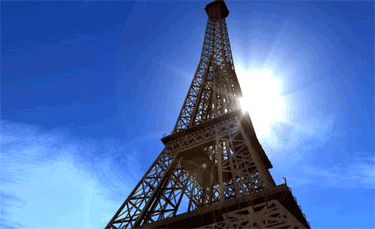Lucidno  The Oldest Film Star of All
The Oldest Film Star of All
|
Let there be Light! And lo there was Cinema! And the Eiffel Tower was featured almost immediately in the new art The fact that a major renovation of the 122-year-old Eiffel Tower is being undertaken, reminds us that no other monument in the world, including the Statue of Liberty, the Houses of Parliament or the Coliseum, conjures up a city with such immediacy, and none with so much romance. According to Roland Barthes, "the Eiffel Tower is nothing but a place to visit. Its very emptiness marked it as a symbol, and the first symbol that it called to mind, by logical association, was inevitably that which one 'visited' at the same time as the tower, namely, the city of Paris. It is Paris by metonymy." During the 12 years I lived in Paris, I hardly ever went near the Tower nor was aware of its presence. Occasionally I saw it in the background but there was no point in visiting it unless one was a tourist. I was far more likely to see this urban icon in its multiform manifestations. For most people, seeing the Tower for the first time is both a familiar and an unfamiliar experience, the structure being so instantly recognisable from the extremes of cheap souvenirs to high art. It is impossible for tourists to come to the Eiffel Tower – the original "Iron Lady" - without bringing their cultural baggage with them. For many literary and artistic figures in the first decades of the 20th century, the Tower was a symbol of modernity. However, in the early days, there were a number of dissenting voices among artists. Maupassant called it an "ungracious giant skeleton", yet ate at its restaurant every day because it was 'the one place in Paris where you couldn't see it". The Paris Opera architect, Charles Garnier, spoke of the "odious shadow of the odious column built up of riveted iron plates". Much later, Jean Cocteau, born in the same year as the Tower, marked his fascination with "the beautiful giraffe in lace" in his libretto for the ballet Les Mariés de la tour Eiffel (The Eiffel Tower Wedding Party, 1921), with music by five of Les Six. An irreverent satire of bourgeois values, it extolled what Cocteau called "the spirit of the new". Blaise Cendras, in his 1913 poem, saw it as an "Ancient God and Modern Beast", while Raymond Queneau poeticised its "tibia stairways". {niftybox background=#8FBC8F, width=360px} The fact that a major renovation of the 122-year-old Eiffel Tower is being undertaken, reminds us that no other monument in the world, including the Statue of Liberty, the Houses of Parliament or the Coliseum, conjures up a city with such immediacy, and none with so much romance. {/niftybox} The Tower was painted by Seurat even before it was finished followed in the early part of the new century by Rousseau, Signac, Bonnard, Utrillo, Vuillard and Dufy, all of whom captured the monument in oils, each seeing it through their own individual prisms. The Tower could almost have been Chagall's signature – a motif representing his overwhelming love for Paris. The Eiffel Tower was the subject of over 30 works by Robert Delaunay in which it was shown from several viewpoints at once, broken into multi-faceted and multicoloured surfaces. The paintings, which suggest the movement of the eye through space and time, are the equivalent of montage in the cinema. Walter Benjamin, in a 1929 essay, called the 12,000 metal fittings and 2.5 million rivets of the Tower "montage in architectural form". Cinema and the Tower made a legitimate couple, both being offsprings of mechanical art and having a relation with riveted architecture - one with its bolts and the other with its splicing. It should be remembered that the Eiffel Tower is only six years older than the cinema, and that the birth and growth of cinema were almost immediately parallel to the birth and growth of modernism in the other arts. |
It is fitting, therefore, that La Ville-Lumière (of which the Tower is the beacon) should have played host to the first public performance of the Cinématographe on 28 December 1895 at the Salon Indian in the Grand Café in the Boulevard des Capucines presented by the brothers Auguste and Louis Lumière. There is a poetic congruity of their name and profession. Let there be Light! And lo there was Cinema! And the Eiffel Tower was featured almost immediately in the new art. In 1897, the Lumière brothers spotlighted it in Panorama pendant l'ascension de la Tour Eiffel (Panorama Whilst Climbing the Eiffel Tower) while Georges Meliès, filmed the Tower in Images of the 1900 Exhibition. The Lumière brothers film Paris from on high René Clair, whose adopted surname means light and bright and whose films have the same reputation for gaiety as Paris, was another movie director to give the Tower a leading role. Paris qui dort (The Crazy Ray, 1925) opens with the young nightwatchman of the Eiffel Tower waking up in the morning and, from his vantage point at the highest point in Paris, discovering that the whole city is at a standstill. On descending (the camera following him dizzily as he runs down the spiral stairway), he finds the streets are filled with stationary cars and motionless people (an effect created with stop-motion photography). They have been victims of a mad doctor who has frozen them with a magic ray. Those people unaffected, having just arrived in Paris by plane, and the watchman, loot the city and go and live in luxury on the Eiffel Tower, which becomes a magical safe place up in the sky. Clair treats the Tower in a Realist, Surrealist and Cubist manner, giving it its first recognition on film as a modernist work of art. Clair also made a vividly composed 14-minute documentary, La Tour (1928), as abstract as it is factual.
Many years later, Louis Malle paid homage to Paris qui dort in Zazie dans le métro (1960): a vertiginous sequence on the Tower uses slow and speeded-up motion. In Charles Crichton's Ealing comedy, The Lavender Hill Mob (1950), it is used as a setting for a madcap chase down the stairs by two bank robbers (Alec Guinness and Stanley Holloway) who have smuggled the stolen gold bullion into France in the form of Eiffel Tower paperweights. It's a case of kitsch souvenir Eiffel Towers meeting the real Eiffel Tower. The Eiffel Tower in Zazie dans le métro In Hollywood, it was a rare Paris-set movie where the Eiffel Tower was not visible from someone's hotel room or apartment. (Actually, since restrictions limit the height of most buildings in Paris to 7 stories, only a very few of the taller buildings have a clear view of the tower.) An establishing shot of the Tower (with a few bars of La Marseillaise to labour the point) was all that was needed to explain where the action was taking place. In Hollywood musicals, no Parisian production number, which always had as much oo-la-la as tra-la-la, could do without it, even if Doris Day in April in Paris (1952) sings of the "Awful awful Eiffel Tower!" in the song "That's What Makes Paris Paree". Ronald Bergan |


